color
With over 600 hoists in our fleet and hundreds of innovative solutions available we are guaranteed to be able to devise the perfect solution for your precise needs. Why not get in touch to talk through your project with our experts?
WHY USE HOISTING?
Our skilled national hoist team is ready to support you in planning, configuring and supplying hoists to meet all your lifting needs, both above and below ground.
We are proud to offer you the largest construction hoist fleet of personnel and materials hoists in Europe, so whether you need support in a solution to build the next Shard or are assessing project plans to go safely underground we're here to help.
With over 600 hoists in our fleet and hundreds of innovative solutions available we are guaranteed to be able to devise the perfect solution for your precise needs. Why not get in touch to talk through your project with our experts with our experts?

Accordion
Passenger &Goods Hoists are used to transport people and materials vertically up a building or structure and down a shaft below ground level with the ability to stop at a number of landings.
The hoist cage is driven by one, two or three geared brake motors, depending on the payload of the cage. The geared motor drives a pinion acting on the mast rack to move the hoist cage in the desired direction. In addition to the drive motors there is a completely independent ‘safety device’ that comes in to play should the hoist cage exceed its rated travel speed in a downward direction. This brings the hoist cage to a controlled stop within three metres of operation.
Hoist cages can be supplied in a variety of sizes: 1.0 - 6.2 metres long, 1.3 – 2.0 metres wide and payload between 500 – 3200Kg. With access to the cage available from three sides, hoists can be configured to suit most applications in construction and industry.
A recent addition to our fleet is the AlimakMammoth 55/46 hoist, which has a 5500Kg capacity and measures 3m wide x 4.6m long.
Different drive technologies and control systems are available to suit the intended use of the hoist and provide a reliable and efficient solution for your hoisting needs.
Contact Us
Our Full Service Cycle
Passenger &Goods Hoists
Passenger &Goods Hoists are used to transport people and materials vertically up a building or structure and down a shaft below ground level with the ability to stop at a number of landings.
The hoist cage is driven by one, two or three geared brake motors, depending on the payload of the cage. The geared motor drives a pinion acting on the mast rack to move the hoist cage in the desired direction. In addition to the drive motors there is a completely independent ‘safety device’ that comes in to play should the hoist cage exceed its rated travel speed in a downward direction. This brings the hoist cage to a controlled stop within three metres of operation.
Hoist cages can be supplied in a variety of sizes: 1.0 - 6.2 metres long, 1.3 – 2.0 metres wide and payload between 500 – 3200Kg. With access to the cage available from three sides, hoists can be configured to suit most applications in construction and industry.
A recent addition to our fleet is the AlimakMammoth 55/46 hoist, which has a 5500Kg capacity and measures 3m wide x 4.6m long.
Different drive technologies and control systems are available to suit the intended use of the hoist and provide a reliable and efficient solution for your hoisting needs.
Passenger &Goods Hoists are usually operated from inside the cage by a trained driver, who responds to calls from site personnel and supervises the safe loading and unloading of the cage at the required landings.

Goods Only Hoists
It is not permitted for passengers to ride in Goods Only Hoists as they are not fitted with a roof. This does, however, enable the vertical transportation of larger items, as long as they are safely contained within the confines of the cage.
Goods Only Hoist cages are equipped with large drop down flaps at either end of the cage to provide a loading ramp to the landing level. This enables pallet trucks and trollies to be moved in to and out of the cage with ease.
The operation of goods only hoists is carried out from the ground level using a pendant control attached to the base electrical enclosure by a cable. This allows the operator to stand back from the hoist, enabling him to see the required landing level and stop the hoist cage within the permitted zone. If the hoist cage stops outside the permitted zone, then it is not possible for the person on the landing to open the landing gate and gain access to the hoist cage for unloading.
Goods Only Hoists are available with cage internal lengths of 1.0 – 6.2 metres, internal widths of 1.3 – 2.0 metres and payloads of 300 – 2500Kg and use one, two or three motor drives as per the Passenger & Goods Hoists.
Bespoke Hoists
Bespoke Hoists can be produced, or existing units modified, in our manufacturing facility. Sunbelt Rentals can engineer bespoke hoists, multiple units and common tower configurations to suit any lifting requirements you may have.
While most hoist applications can be fulfilled by configuration of standard hoist components, our fully equipped workshops can modify hoist cages and accessories for those awkward requirements.
Hoist cages can be adapted to suit different sizes and shapes of existing lift shafts or finished in our customers' own brand colours.
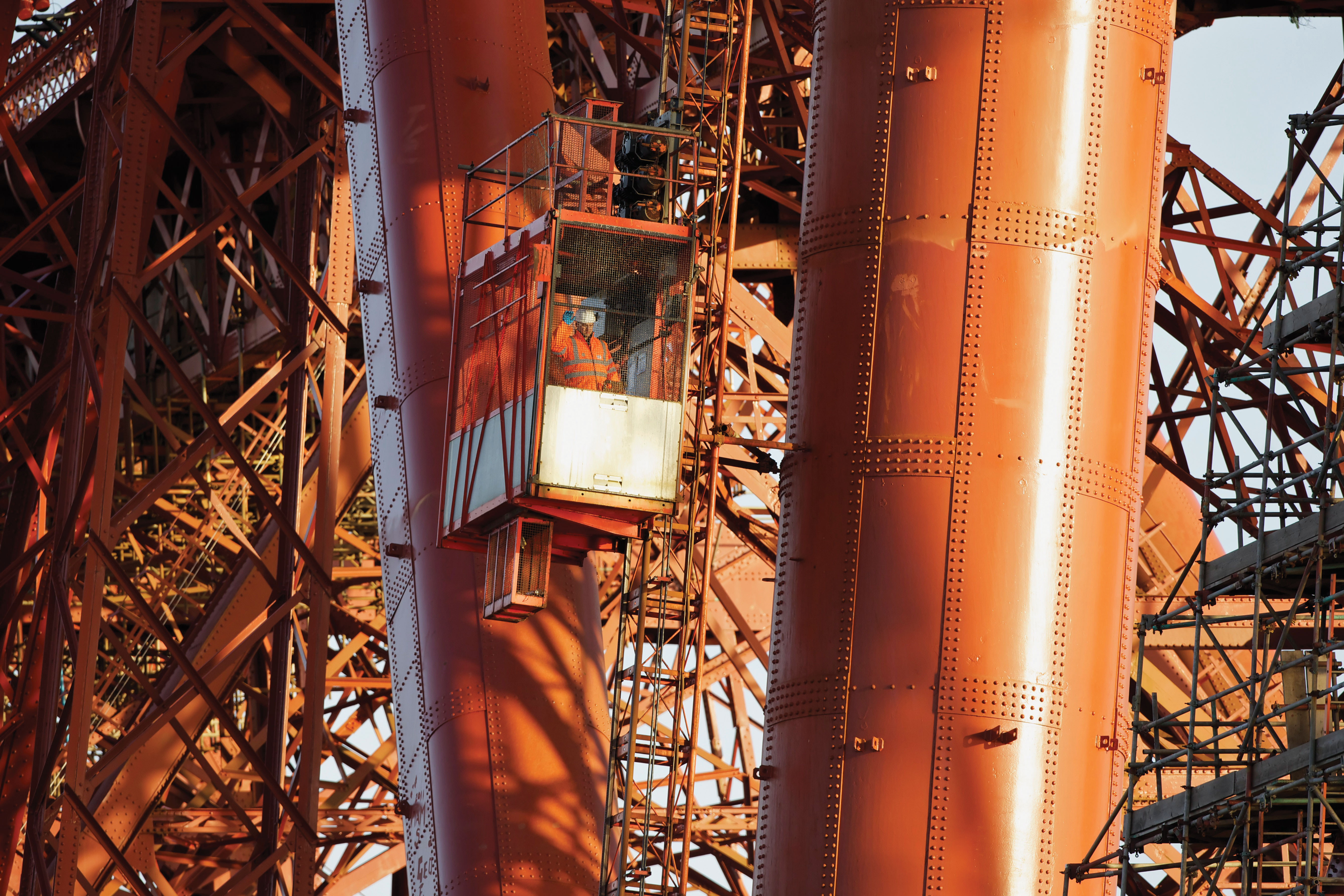
Beam Hoists
Beam Hoists are most commonly found on city centre construction sites adjacent to main roads with no off-road unloading facilities. These sites typically have a scaffold gantry built out over the pavement and delivery vehicles pull up alongside the gantry to be offloaded.
The Beam Hoist is an 'I' section beam, mounted on the site scaffolding and extends past the outer edge of the gantry. A motorised trolley unit, which has an electric winch suspended from it, runs along the beam. This enables materials to be lifted from the delivery vehicle, transporting them via the trolley onto the gantry for distribution to the workplace.
Winch units are available with a variety of chain lengths and 1000 or 2000Kg lifting capacity.
All Sunbelt Rentals winches operate at 415 volts, 3 phase - to give added reliability - and are controlled from an attached pendant.
Please note that Sunbelt Rentals only supplies beam hoists as part of a package with a Goods Only or Passenger& Goods Hoists.
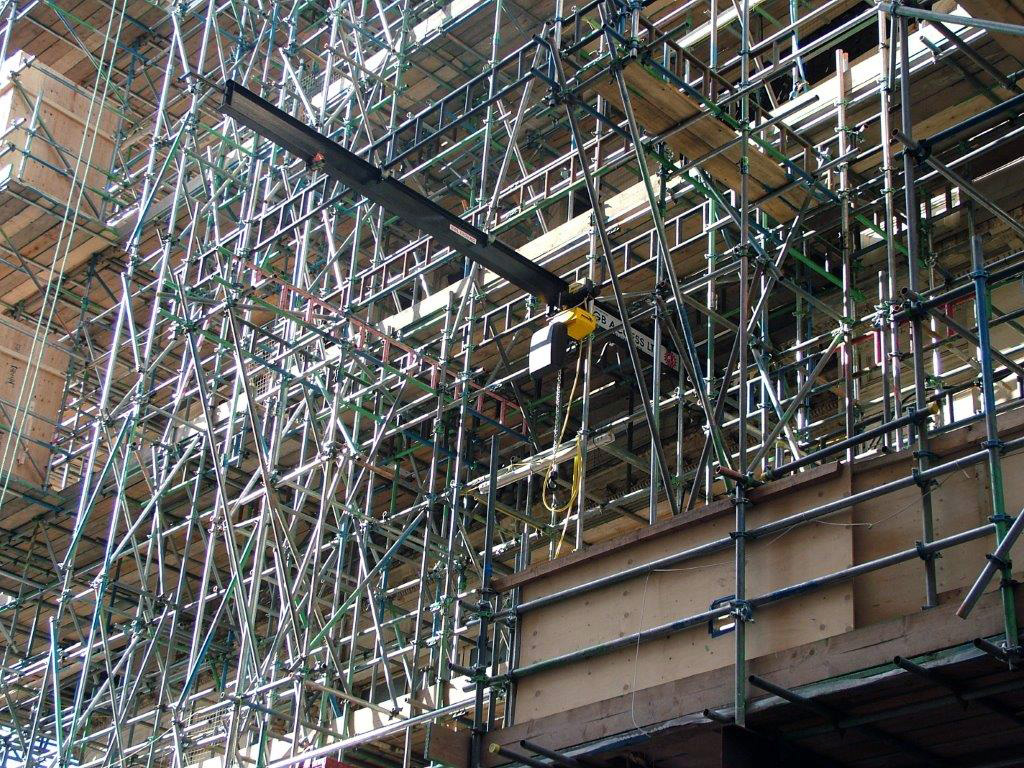
Accessories
To enable our standard hoist cages and industrial lifts to be configured for maximum safety and efficiency, Sunbelt Rentals offers a range of accessories that are available for most hoists. These include:
Landing Protection Panels – The panels are fitted either side of the landing gate to prevent site staff from touching the hoist cage as it travels past – or stops at – the landing. These are secured to the hoist vertical pipe superstructure and are fitted during the hoist installation.
Landing Infill Plates – Infill plates are installed to bridge the gap between the hoist superstructure and the site landings. The use of landing infill plates also restricts the gap between the hoist cage floor edge and landing edge to below 50mm as required by BS7212.
Foundation Steel Plates – Designed to avoid the necessity to fix the hoist base assembly down to concrete floors, or where the hoist is placed on a soft surface. GB Access can supply a steel plate to go under the hoist base which is bolted down to the plate. The standard F S P plate size is 4000 x 2500 x 40mm and weighs 3200Kg, which is sufficient to absorb the upwards forces in the event of a hoist striking the bottom buffers.
Landing Bridges – Where the hoist is mounted away from the building or scaffolding landing edge, we can supply and install a landing bridge. This will provide a safe walkway between the hoist cage and landing. The landing bridges are equipped with protection panels at the hoist end and full length handrails and toeboards to minimise the risk of items falling from the bridge.
Landing bridges are the same width as the hoist cage and available in lengths up to 6.0 metres.
Top Hats – These are available to be fitted to the roof of passenger goods hoists over the cage roof trapdoor. This allows the safe transportation of long items within the cage / top hat, without the possibility of the load falling from the hoist cage.
Pipe Carriers – These can be fitted to goods only hoists and enable scaffold poles etc. to be carried safely.
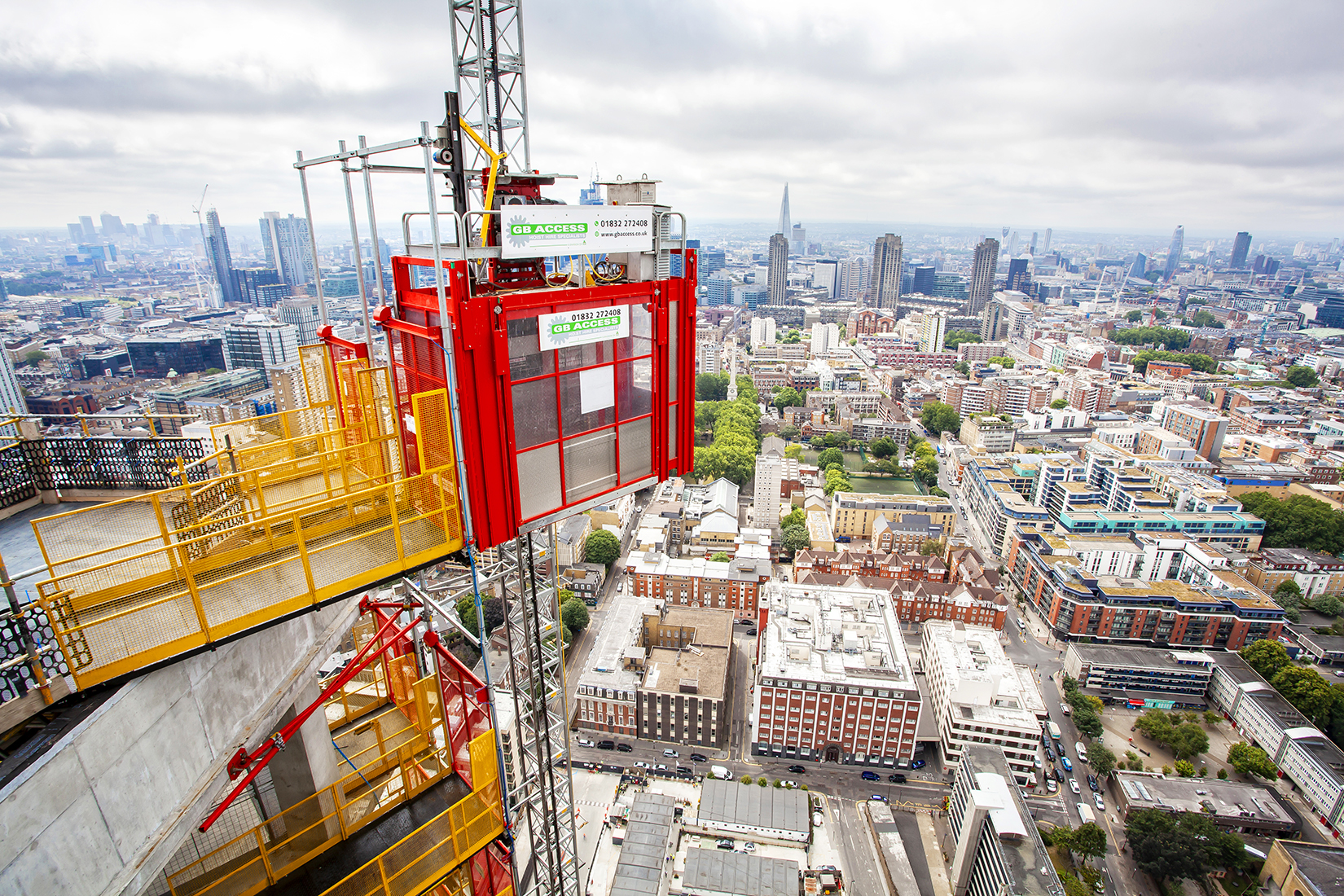
Design & Engineering
TEXT AND IMAGE TO FOLLOW – use ‘lorem’ for now for text and blank holding space for image

Delivery
Delivery of our rental hoists is typically made by one of our rigid lorries fitted with a Palfinger lorry mounted crane, equipped with lifting accessories and driven by a trained driver / operator.
All deliveries of our hoist equipment to site are planned in advance to ensure minimum site disruption and inconvenience. Our delivery fleet of 8 wheel construction chassis vehicles can self-offload and position the hoist base assembly at up to 12 metres of the vehicle, depending on site conditions.
Our FORS registered HGV fleet is Crossrail compliant and fitted with the latest emissions controls, allowing them to carry out deliveries anywhere in the UK.
Some of our larger hoist cage / base assemblies exceed 2.9 metres width and travel as ‘Abnormal Loads’. When this is required, Sunbelt Rentals registers the Abnormal Load movement and travel in accordance to the requirements of the movement order. Within the Metropolitan Police area these restrict the movement times of the vehicle and, in these instances, sites are advised of the early delivery time to ensure that the site is open to receive the delivery.
Deliveries are met by Sunbelt Rentals installation engineers and supervisors to guide the vehicle to the correct location and position the hoist according to prepared installation drawings, following the site indicated grid lines, where available.
Toolbox talks are carried out with the hiab operator and installation engineers to ensure that all members of the team understand what is required and all safety matters are explained so the necessary control measures are in place prior to offloading and placing the delivery.
All mast sections, superstructure and ancillary items are offloaded adjacent to the installation site to minimise manual handling during the installation.
Where site tower cranes are available to place the hoist away from the access roads or for all slipform hoist installations, our installation engineers will liaise with the site banksman to ensure that the hoist equipment is slung correctly and placed according to the installation drawings and site preparation.
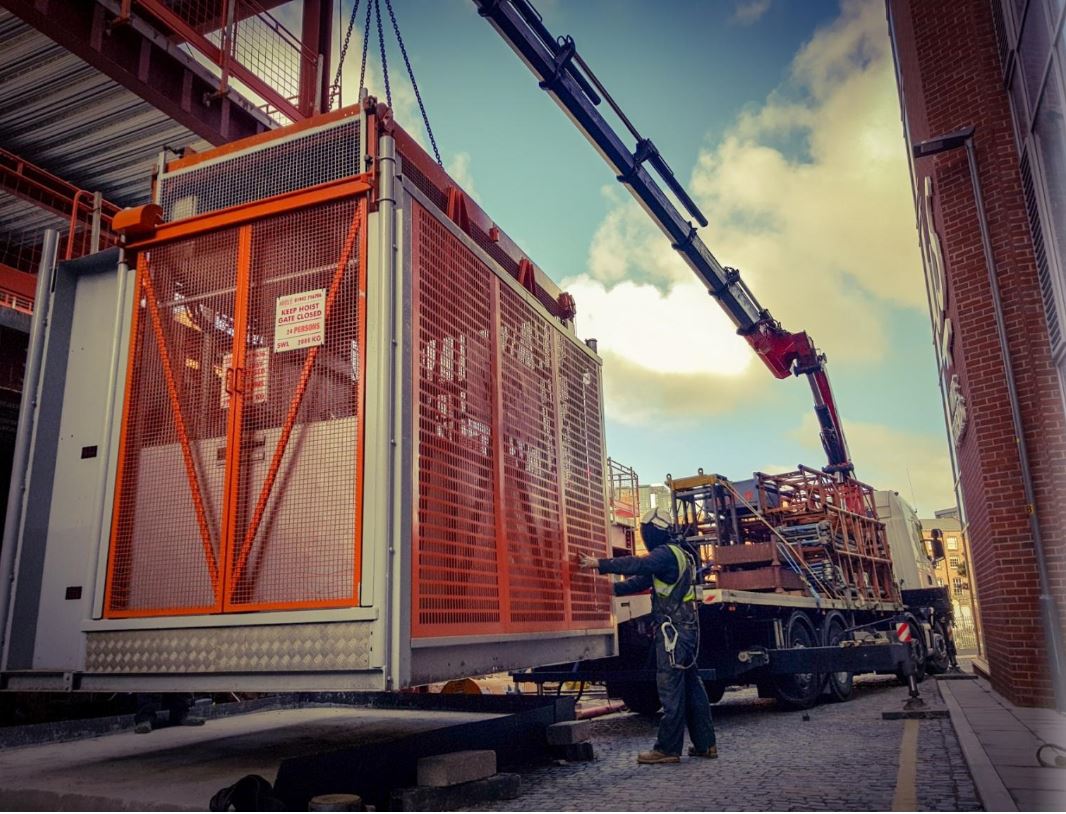
Installation
Installation of our rental or customers' own hoists is carried out by our experienced and competent site engineers from supplied drawings and site information. All work is carried out efficiently and at competitive rates
The safety of our installation team and that of everyone on site is a priority for Sunbelt Rentals, who plan and manage the installation in detail.
Before the installation takes place, a Sunbelt Rentals site supervisor will visit site and inspect the installation area, access routes and general site conditions. This information is fed into Sunbelt Rentals systems to enable accurate installation drawings, method statements and risk assessments to be produced by trained, competent professionals.
The hoist mast height is extended either by using a ‘self-erect’ jib and winch or using a site tower crane, reducing working at height.
The mast stick is secured to the building / structure through tie assemblies, configured to suit the hoist type and fixings into or onto the structure. Where hoists are installed onto new buildings, Sunbelt Rentals encourages the use of tie embedment sockets connected to the slab rebar before the slab concrete is poured, to eliminate the need to drill the floor slab and fit mechanical anchors.
Due to the nature of our work it is essential that control measures are in place while working at height. All installation engineers are trained to work at height and provided with the correct Work at Height PPE including full body harnesses, fall arrest and work positioning lanyards, which are inspected in line with the Work at Height Regulations.

Testing
Testing of all hoist installations is required under LOLER regulations following installation, at regular intervals (six months for passenger / goods hoists and 12 months for goods only and beam hoists) or following modification. These tests are undertaken by a Sunbelt Rentals qualified Thorough Examiner.
Carrying out a thorough examination of the hoist following installation, partial dismantle, modification or significant mechanical damage is required under LOLER regulations.
A visual inspection is made of the complete installation by a competent person trained to carry out the thorough examination, who will also check the integrity of all connections on the mast, superstructure and ties before carrying out a load test.
This consists of loading the hoist with 125% of its Safe Working Load and driving the hoist up its full length of travel, stopping the cage near to the tie points to check both the structural integrity of the mast and superstructure as well as the holding ability of the drive motor brakes.
When the hoist receives its routine test (at six monthly intervals for passenger goods hoists or 12 monthly intervals for goods only hoists) the load test is carried out with the hoist SWL weight only.
Following a satisfactory load test, the hoist manufacturer’s patented safety device is drop tested with the Safe Working Load of the hoist. This is designed to bring the descent of the hoist to a controlled stop within 2 metres, if the descent speed is greater than 125% of normal, ensuring the safety of the occupants.
Following the load and drop test, the structure is inspected again to ensure that there has been no deterioration from the tests and that all aspects of the hoist operate correctly before Sunbelt Rentals issues a Report of Thorough Examination.

Maintenance
Maintenance and repair of customers' own rack and pinion lifts or hoists is carried out by Sunbelt Rentals service / maintenance engineers at an agreed schedule and rates.
To ensure that your rack and pinion lift / hoist runs at optimal efficiency and safety, it is important to follow the manufacturer’s maintenance schedule and have all works carried out by competent, trained engineers.
Sunbelt Rentals maintenance engineers are trained in all aspects of rack and pinion technology and can maintain, repair and carry out mandatory testing of your own equipment to an agreed schedule.
All safety critical replacement parts are sourced from the manufacturers and fitted on site to best practice standards.

Dismantle
Dismantle of hoists often presents more challenges than the installation due to changing site conditions and access routes. A pre-dismantle site visit is usual before our trained engineers start the dismantle and removal of the hoist
Sunbelt Rentals places as much importance on the dismantle and collection of their rental hoists as their delivery and installation.
At a time when many sites are nearing completion, it is essential that the hoist is removed swiftly and safely after other trades have finished lifting all required materials.
If the dismantle and collection of the hoist is not straightforward, a Sunbelt Rentals site supervisor will carry out a site inspection and identify any problems or obstacles to getting the hoist out; for example there may have been a tower crane available for the installation which has been dismantled and removed.
The dismantle of slipform hoists follows a set procedure whereby the tower crane is used to dismantle the mast sections and release the tie tubes from the mast down to ground level. A man riding basket is then attached to the crane and this is used to remove the tie tubes and plates from the core.
Collection of the dismantled equipment is made using our Palfinger equipped rigid vehicles at agreed times.

Customer Training
Training of hoist drivers is not always provided by hoist rental companies, several providing a familiarisation of the hoist controls only. Sunbelt Rentals offers a site specific hoist operator training session to all customers to ensure that the hoist is operated safely, in accordance with manufacturers' instructions and guidelines.
The safe operation of any construction hoist relies on the competence of the hoist operator(s). As well as driving the hoist, occupants and loads to the correct upper floor, they will normally carry out the daily inspection and, in some instances, the weekly inspection as well.
To enable the hoist operation and mandatory inspections to be completed to best possible practice, the operator should be trained on the actual site restraints and the particular hoist under his – or her – control. This is often in addition to holding a CPCS Hoist Operator card.
The operator should be aware of the legislation surrounding the use of the hoist, his responsibilities while this vital piece of equipment is in his care and the procedure to document the daily / weekly checks, and report any malfunction or maintenance concerns. These are all covered in a classroom session as part of a Sunbelt Rentals hoist operator training course.
If the hoist or the power supply fails during use, the operator is the person responsible for lowering the hoist, typically to the next available landing, so that the occupants can exit the cage. Sunbelt Rentals operator training includes a practical session where every operator is taught how to lower the hoist and carries out this procedure as part of the assessment.
Where potential operators do not meet the standards required, our trainer will fail them and explain the areas where they would need to improve to pass the assessment.
Sunbelt Rentals also carries out ‘scaffolders handover training’, where site scaffolders are trained to use a hoist without landing gates to reduce manual handling during scaffold installation or dismantle.
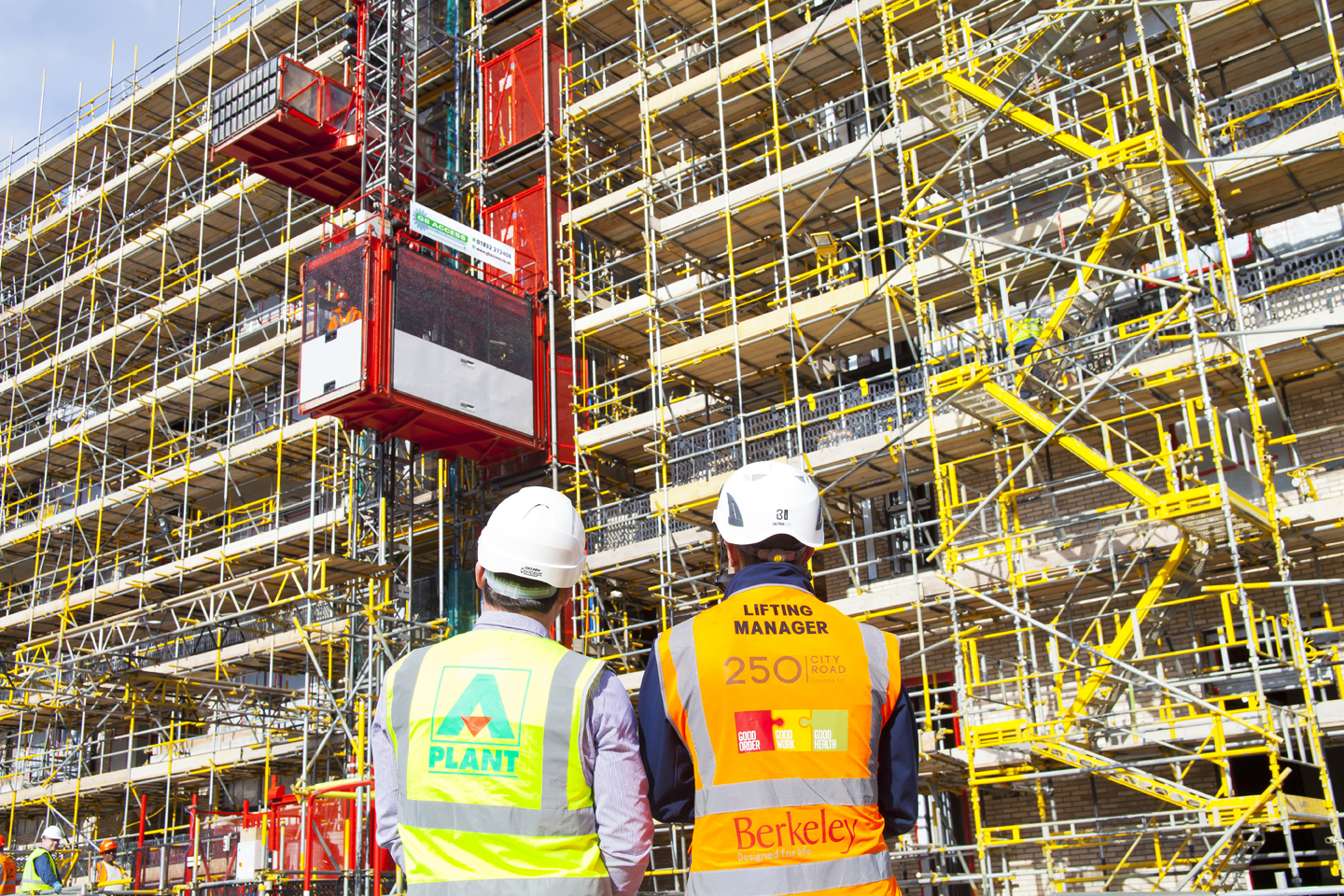
test
test test test test test test test test test test test test test test test test test test test test test test test test test test test test test test test test test test test test test test test test
In April 2020, Oxford University Hospital Trust contacted Sunbelt Rentals to supply Face Fit Testing for 6000 of their front line staff throughout COVID-19.
Case Studies
Social impact

Social impact

Social impact

Title
For all enquiries please talk to our specialist team:
Wigan: 01942 716 706, hoists@sunbeltrentals.co.uk
Peterborough: 01832 272 408, hire@gbaccess.co.uk



 eeeeeeeeeeeeeeeeeeeeeee
eeeeeeeeeeeeeeeeeeeeeee  rrrrrrrrrrrrrrrrrrrrrrr
rrrrrrrrrrrrrrrrrrrrrrr 